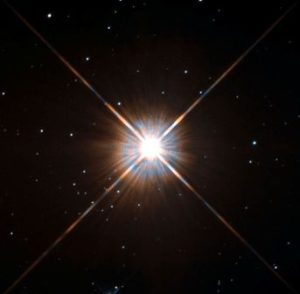 This has been a puzzle to many people. If light from the most distant stars has taken millions of light years to reach us, how can the earth be only thousands of years old? The belief that “light from the most distant stars has taken millions of years to reach us” is based on two major assumptions: (1) the distance and (2) the speed at which light travels.
This has been a puzzle to many people. If light from the most distant stars has taken millions of light years to reach us, how can the earth be only thousands of years old? The belief that “light from the most distant stars has taken millions of years to reach us” is based on two major assumptions: (1) the distance and (2) the speed at which light travels.
Distance. Star distances are measured in two ways. Nearby planets and stars are measured by “triangulation.” The earth travels in what is essentially a circle around the sun. Measurements of the angle of a given star made at six-month intervals are on the base of a tall isosceles triangle. The height of the triangle is the distance to that star. This method becomes impractical for all except those stars closest to earth. The alternative “red-shift” method must be used for more distant stars.
The beginning assumption with the red-shift method is that the universe began with the Big Bang at one point, and every star and galaxy has since been flying away from that point in every direction. The more remote the star is from its origin, the greater the speed. When the light source is traveling away from the observer, the light is shifted toward the red end of the spectrum. The greater the red shift, the greater the speed – and consequently the greater the distance. There are a chain of assumptions here that have been seriously challenged from within the astrophysical fraternity itself. All of them pose the question: How can we be sure those distances are really as great as advertised?
Speed. The other major assumption is that the speed or velocity of light is a physical constant. In other words, it is assumed that the velocity has always been the same throughout the history of the universe. Actually, it was never assumed to be constant until Albert Einstein declared it to be so and thus validated his Theory of Relativity.
The velocity of light has been measured many times over the past two centuries. After rigorous statistical analysis of the data, the conclusion is that there has been an historical decrease in velocity. To be sure, there is scatter in the magnitude of the decrease, but the direction of change is consistently decreasing. Of course, it is a dangerous practice to extrapolate this trend backward much beyond two centuries. But if the velocity of light was indeed much greater in the past, then light from the most distant stars could have reached earth in possibly a few thousand years and not millions.
We cannot know this, but the hard data do raise some questions about dogma in science. How do we know there is not some physical principle at work here of which science is not yet aware? After all, the Second Law of Thermodynamics is well established, and it would be reasonable to expect that the velocity of light would be no exception to this Law.
All this is to say that the statement about light having taken millions of years to reach us is based upon a tottering pile of assumptions that, in sum, support the long ages and, thus, the theory of evolution.
Footnotes:
Photo: Shining brightly in this Hubble image is our closest stellar neighbor: Proxima Centauri. Courtesy of ESA/Hubble. Licensed under the Creative Commons Attribution 3.0 Unported license.
© 2021 Creation Moments. All rights reserved.
